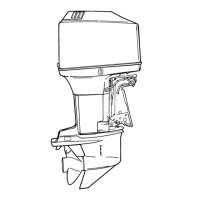1C-2 - IMPORTANT INFORMATION 90-824052R3 JUNE 2002
Boat
WEIGHT DISTRIBUTION
1. Proper positioning of the weight inside the boat
(persons and gear) has a significant effect on the
boat’s performance, for example:
a. Shifting weight to the rear (stern)
(1.)Generally increases top speed.
(2.)If in excess, can cause the boat to por-
poise.
(3.)Can make the bow bounce excessively in
choppy water.
(4.)Will increase the danger of the following
wave splashing into the boat when com-
ing off plane.
b. Shifting weight to the front (bow)
(1.)Improves ease of planing off.
(2.)Generally improves rough water ride.
(3.)If excessive, can make the boat veer
back-and-forth (bow steer).
BOTTOM
1. Boat Bottom: For maximum speed, a boat bot-
tom should be nearly a flat plane where it con-
tacts the water and particularly straight and
smooth in fore-and-aft direction.
a. Hook: Exists when bottom is concave in fore-
and -aft direction when viewed from the side.
When boat is planing, “hook” causes more lift
on bottom near transom and allows bow to
drop, thus greatly increasing wetted surface
and reducing boat speed. “Hook” frequently
is caused by supporting boat too far ahead of
transom while hauling on a trailer or during
storage.
b. Rocker: The reverse of hook and much less
common. “Rocker” exists if bottom is convex
in fore-and-aft direction when viewed from
the side, and boat has strong tendency to
porpoise.
c. Surface Roughness: Moss, barnacles, etc.,
on boat or corrosion of motor’s gear housing
increase skin friction and cause speed loss.
Clean surfaces when necessary.
d. Gear Housing: If unit is left in the water, ma-
rine vegetation may accumulate over a peri-
od of time. This growth MUST be removed
from unit before operation, as it may clog the
water inlet holes in the gear housing and
cause the engine to overheat.
TRIMMING OUTBOARD “OUT” (“UP”)
WARNING
Excessive trim “out” also may reduce the stabil-
ity of some high speed hulls. To correct instabili-
ty at high speed, reduce the power GRADUALLY
and trim the outboard “in” slightly before resum-
ing high speed operation. (Rapid reduction in
power will cause a sudden change of steering
torque and may cause additional momentary
boat instability.)
1. Will lift bow of boat, generally increasing top
speed.
2. Transfers steering torque harder to left on single
outboard installations below 23 in. (584mm)
transom height.
3. Increases clearance over submerged objects.
4. In excess, can cause porpoising and/or
ventilation.
5. If trimmed out beyond the water pickup, reduced
water supply can cause overheating resulting in
engine damage.
TRIMMING OUTBOARD “IN” (“DOWN”)
CHARACTERISTICS
WARNING
Excessive speed at minimum trim “in” may
cause undesirable and/or unsafe steering condi-
tions. Each boat should be tested for handling
characteristics after any adjustment is made to
the angle (trim adjustment bolt relocation.)
1. Will help planing off, particularly with a heavy
load.
2. Usually improves ride in choppy water.
3. In excess, can cause boat to veer to the left or
right (bow steer).
4. Transfers steering torque harder to right (or less
to the left) on single outboard installations.
5. Improves planing speed acceleration (by moving
trim adjustment bolt one hole closer to transom).

